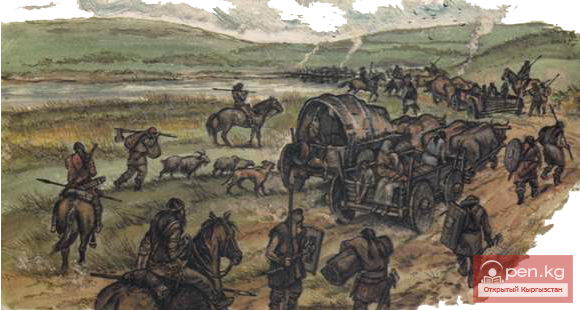Elders - Real Power in Kyrgyz Society
Before joining Russia, there existed the institution of kurultai. It was convened rarely and only to address momentous issues. A kurultai could be convened by a single tribe independently or by a group of tribes with prior agreement. For instance, in 1825, a kurultai of the Bugyn Kyrgyz was convened in the Zhyrgalan area on the Tyup River (Issyk-Kul), where the question of the Bugyn tribe accepting Russian citizenship was discussed; in 1842, a kurultai was convened in the Kyzyl-Saz area on the western shore of Lake Issyk-Kul with the participation of several major northern Kyrgyz tribes, where the supreme manap of the Sarybagysh tribe, Ormon, was proclaimed khan (Usenbaev, 1999). Not only tribal biys participated in the kurultai, but also other influential people in their tribe, batyrs.
The composition of participants in the intertribal kurultai was personally selected by the head of the tribe. The supreme biy maintained a permanent armed retinue of jigits and personal security of jasool.
At the next level was the authority of the tribal biy. He was formally subordinate to the elders of the aiyl - aksakals, who in turn were the heads of patronymic associations - bir atanyn baldary "children of one father."
The tribal biy exercised administrative and judicial functions. The former included determining the days of migrations, the order of movement of people and livestock, mobilizing resources, and participating in tribal events. The latter functions involved considering civil and criminal cases, determining the measure of punishment, and collecting fines from offenders. The tribal biy relied on the elders of the patronymic associations. Several jigits could be near him, carrying out assignments. The authority of the tribal biy was limited to the boundaries of his tribe; the power could be inherited by one of his children, but it could also pass to another authoritative person within the tribe.
The real power within the family group was held by the elders - aksakals, who closed the vertical structure of governance in Kyrgyz society. Aksakals were not only elderly men with gray beards but also those who, due to the absence of older individuals, stood at the head of the patronymic - a family-kin group of bir atanyn baldary. This group represented the primary structure of the tribe. The main unit of the group was the family of two types: a large patriarchal family (in the form of an extended or undivided family) and a small individual (monogamous) family. Family-kin groups consisted of several dozen families of tutun, whose members were in real blood-kin relationships and were named after a common ancestor, to whom they traced back 4-5-7 generations. Each member of the group knew the names of the ancestors of their kinship line and branches within the group. Family-kin groups were exogamous, and marriages within them were strictly prohibited. The authority of the elder extended to all members of the family-kin group, accordingly - to the members of specific families. The elder mainly performed administrative-economic and educational functions. He sometimes acted as a mediator when approached for resolving minor disputes and violations. It was in the small tribal subdivisions that the "complex of living and actively functioning phenomena of patriarchal-tribal life" and the "living" form of tribal organization were preserved, as well as a peculiar remnant of patriarchal family communities (Abramzon, 1990, p. 193).
Such a vertical power structure was characteristic of almost all Kyrgyz.
While there was autonomy in resolving household issues within the family-kin group, there were questions that were addressed at the level of the tribe or clan - primarily regarding the beginning of the migration cycle, the use of pastures, the holding of large celebrations, determining the composition of guests, the order of hospitality, the sizes of prizes, accusations of murder, and organizing raids. During periods of heightened military-political situations, tribal subdivisions, by the order of the tribe's leader, tried to stay close to each other so that migrations formed a chain along the river, having advantageous positions for repelling sudden enemy attacks. And during migrations in unstable times, they organized protection for the migration. In this regard, the organization of the migration of the Bugyn tribe (Issyk-Kul Kyrgyz), which dates back to the first half of the 19th century, is of interest.
The leaders of the Bugyns, Boronbay and Murataaly, convened tribal leaders and aiyl elders for a tribal council, where issues regarding the appointment of the migration day for the tribe, the order of movement, and the protection of the migration were discussed (the territory of the Bugyn migration included the Issyk-Kul basin and mountain pastures stretching from Kulja to Tekes). Well-known batyrs were assigned the following order of protection for the migration: the protection of the northern shore of the lake was entrusted to Batyr Balbay, the southern shore to Batyr Janek, and the eastern shore to Batyr Omur (Vmur). Their task was to repel sudden enemy attacks with their warriors (Kyrgyzdar, 1991, p. 527). On the appointed day, all tribal subdivisions and aiyls were required to move from their places.
The Power System among All Groups of Kyrgyz in the Late 18th - First Half of the 19th Century.













































